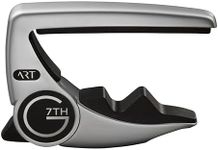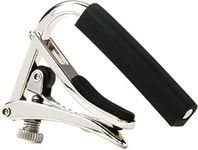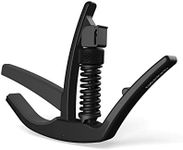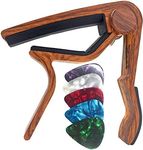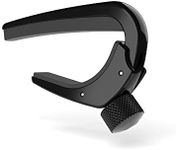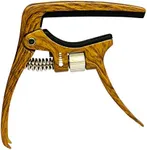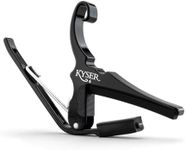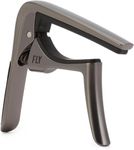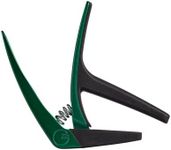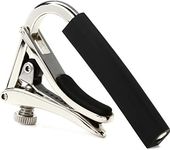Buying Guide for the Best Acoustic Guitar Capos
Choosing the right capo for your acoustic guitar can significantly enhance your playing experience by allowing you to easily change the key of your guitar without having to retune or learn new chord shapes. A capo is a small device that clamps down across the guitar's fretboard at a particular fret, effectively shortening the strings and raising their pitch. When selecting a capo, consider the type of music you play, the neck profile of your guitar, and how often you plan to use it. The right capo should be easy to use, fit your guitar well, and not interfere with your playing style.MaterialThe material of a capo affects its durability, weight, and how it interacts with your guitar strings. Common materials include metal, plastic, and rubber. Metal capos, such as those made from stainless steel or aluminum, are durable and provide a firm grip, making them suitable for frequent use. Plastic capos are lighter and often more affordable, but they may not last as long. Rubber is typically used for the part of the capo that contacts the strings, providing a soft grip that minimizes damage to the strings and fretboard. Choose a material that balances durability with comfort and ease of use for your playing style.
DesignCapos come in various designs, including trigger, screw, and strap styles, each offering different levels of convenience and precision. Trigger capos are popular for their quick and easy one-handed operation, making them ideal for live performances or quick changes. Screw capos allow for more precise tension adjustment, which can be beneficial for avoiding string buzz or tuning issues, but they take longer to position. Strap capos are lightweight and simple, often used for their minimalistic design. Consider how often you need to change the capo's position and your preference for ease of use versus precision when selecting a design.
Tension AdjustmentTension adjustment refers to how tightly the capo holds the strings against the fretboard. Proper tension is crucial to ensure that the strings are pressed down firmly enough to produce clear notes without causing tuning issues or damaging the strings. Some capos have adjustable tension, allowing you to fine-tune the pressure to suit your guitar's neck and string gauge. Others have fixed tension, which can be convenient but may not work well with all guitars. If you play different guitars or use various string gauges, an adjustable tension capo might be more versatile for your needs.
CompatibilityCompatibility is about ensuring the capo fits your guitar's neck profile and string spacing. Acoustic guitars can have different neck shapes, such as C-shaped or V-shaped, and varying widths. A capo that fits well will apply even pressure across all strings, preventing buzzing or muted notes. Some capos are designed to be universal, while others are tailored for specific neck profiles. It's important to check that the capo you choose is compatible with your guitar's neck to ensure optimal performance. If you have multiple guitars, you might want a capo that can accommodate different neck shapes and sizes.
Ease of UseEase of use refers to how simple it is to attach, adjust, and remove the capo from your guitar. A capo that is easy to use can make your playing experience more enjoyable, especially if you frequently change keys or move the capo during performances. Look for a capo that can be operated with one hand if you need quick changes, or one that has a straightforward mechanism if you prefer simplicity. Consider your playing style and how often you plan to use the capo to determine the level of convenience you need.
